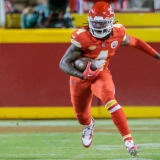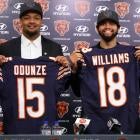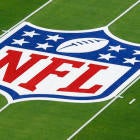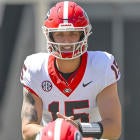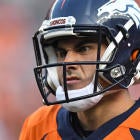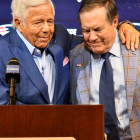
The NFL is a passing league. You know this. I know this. Everyone in and around the league knows this. And because it's a passing league, the wide receiver position has never been more important than it is right now. Perhaps it's no coincidence, then, that there are seemingly more young, good wide receivers populating the league than at any time in recent memory.
With that in mind, we're going to use this space over the next few weeks to highlight of the league's up-and-coming wideouts. Because I'm a little obsessive about this kind of stuff, we're going to break the players down into distinct categories that capture their on-field roles: Speed Demons and Deep Threats (last week), Slot Mavens and Offensive Weapons (below), Possession Receivers (next Friday), Technicians (Dec. 25), and All-Around Monsters (Jan. 1).
A couple of quick notes before we dive into the first category of players:
- The only receivers we're looking at here at players who are still on their rookie contract. That means no Davante Adams, no Julio Jones, no DeAndre Hopkins, no Keenan Allen, no Tyreek Hill, etc. We already did our in-depth look at those guys before the start of the season. While there is one player who made our top-10 list (and two who were honorable mentions) that will be featured during this series, for the most part, we are just looking at the youngsters, which means focusing on players whose future is likely brighter than their present.
- We're not exclusively looking at the best receivers, but instead all of the receivers still on their rookie deals who fit a certain mold, and have already proven to be at least nominal contributors to their offenses. Basically, anyone who has at least 15 targets this season qualifies.
Without further ado, let's dig into the slot mavens and offensive weapons (with 2020 statistics, via Pro Football Focus and Tru Media)...
| Player | AGE | YRS | RTE | REC | TGT | YDS | TD | YDS/RTE | TGT % |
|---|---|---|---|---|---|---|---|---|---|
| Anthony Miller | 26 | 3 | 352 | 42 | 65 | 433 | 2 | 1.23 | 18.5% |
| Braxton Berrios | 25 | 3 | 163 | 26 | 39 | 256 | 2 | 1.57 | 23.9% |
| CeeDee Lamb | 21 | 1 | 403 | 59 | 89 | 696 | 4 | 1.73 | 22.1% |
| Chris Godwin | 24 | 4 | 300 | 49 | 59 | 562 | 3 | 1.87 | 19.7% |
| Cooper Kupp | 27 | 4 | 415 | 74 | 100 | 836 | 2 | 2.01 | 24.1% |
| Hunter Renfrow | 25 | 2 | 277 | 42 | 54 | 556 | 2 | 2.01 | 19.5% |
| JuJu Smith-Schuster | 24 | 4 | 476 | 73 | 92 | 600 | 6 | 1.26 | 19.3% |
| Keke Coutee | 23 | 3 | 90 | 14 | 18 | 179 | 1 | 1.99 | 20.0% |
| Russell Gage | 24 | 2 | 367 | 49 | 76 | 522 | 2 | 1.42 | 20.7% |
| Brandon Aiyuk | 22 | 1 | 317 | 40 | 62 | 541 | 4 | 1.71 | 19.6% |
| Cedrick Wilson | 25 | 3 | 129 | 16 | 26 | 186 | 2 | 1.44 | 20.2% |
| Curtis Samuel | 24 | 4 | 309 | 54 | 62 | 517 | 3 | 1.67 | 20.1% |
| Deebo Samuel | 24 | 2 | 173 | 33 | 44 | 391 | 1 | 2.26 | 25.4% |
| Devin Duvernay | 23 | 1 | 162 | 19 | 23 | 201 | 0 | 1.24 | 14.2% |
| Isaiah McKenzie | 25 | 4 | 71 | 18 | 19 | 171 | 3 | 2.41 | 26.8% |
| Laviska Shenault Jr. | 22 | 1 | 255 | 36 | 44 | 392 | 2 | 1.54 | 17.3% |
This is a really interesting group of players, and in some ways, the group that allows for the most creativity from offensive coordinators. These are the guys who are most often the target of gadget plays, jet sweeps, and end-arounds -- some of them even line up in the backfield and take a regular ole hand-off on occasion. They've combined for 78 carries this year, making them responsible for a little more than 23 percent of all wide receiver rushing attempts league-wide.
They do a lot of their passing-game work close to the line of scrimmage: with an average route-break depth of just 6.8 yards downfield, they often provide a security blanket for their quarterback on underneath throws and/or bubble screens. Because they tend to work in close, they produce explosive plays less often (16.9 percent of their targets) than any other group we're watching, despite having a target rate on par with their peers. Our slot mavens and offensive weapons have been targeted on 20.4 percent of their routes this season, per PFF and Tru Media, compared with 20.8 percent for possession receivers, 20.9 percent for the all-around monsters, and 21.6 percent for the technicians. (The speed demons and deep threats are targeted far less often, for obvious reasons.)
What's most interesting about this group of players is the disparate ways in which they are used.
You've got the pure, old-school slot guys like Miller (90 percent of routes in the slot), Berrios (69percent), Coutee (73 percent), and Gage (71 percent). They work from the inside because they're smaller and/or slighter, and it gives them freer releases off the line of scrimmage. They've got the quickness in and out of breaks to provide an opening within that precious 2-second window after the snap, and throws to them can often work like extensions of the run game. But those guys are mostly complementary players; they're not out there on an every-snap basis. The same is true, to an even greater extent, of the gadget guys.
Wilson has played only 21 percent of Dallas' offensive snaps this season, but he's out there just often enough that when the team gets him the ball on an end-around or a reverse-pass (like the one he threw to Dak Prescott for a touchdown against the Giants), it doesn't seem like a gimmick, because he actually does work into the rotation throughout the game. Duvernay has actually been in on 37 percent of the Ravens' snaps, but his 14.5 percent target rate is almost shockingly low. Some of that is because the Ravens don't throw all that often to begin with and want to get the ball to their best playmakers, but some of it is because they don't appear to have a defined plan for him just yet, and thus have to design touches to make sure he gets the ball, which takes them out of their offense. McKenzie, who has played 18 percent of the Bills' snaps, is somehow more seamlessly integrated into his team's offense, and he's Buffalo's preferred target on all of their jet flips and wide receiver hand-offs.
Then, you've got guys like Lamb, Godwin, Kupp, and Smith-Schuster, who are starting wide receivers that just happen to play in the slot for various reasons. The Cowboys have stud perimeter receivers in Amari Cooper and Michael Gallup, so they let Lamb go to work on the inside, where he has more room to pick on nickel corners. Godwin lines up inside more as a proactive tactic, with the Bucs preferring to use him there so he can gain a physical advantage over the smaller cornerbacks who tend to play inside. Kupp benefits from the free releases lining up off the line of scrimmage affords to slot receivers (he's not particularly fast), but he's also arguably the best blocking wide receiver in the league right now, and aligning close to the formation allows him greater participation in the run game. Smith-Schuster is slight and not particularly fast, but he's quick in and out of his breaks, and lining him up in the slot allows the Steelers to use him heavily in the screen game, where they can use bigger wideouts like Chase Claypool to throw some blocks out in front of him.
My favorite guys to watch, though, are Aiyuk, Deebo Samuel, Curtis Samuel and Shenault. These guys are basically wide receiver/running back hybrids whose coaches try to get them the ball however, whenever, wherever they can. Deebo Samuel had a game where he had a negative average depth of target. Aiyuk's first two career touchdowns were runs. Curtis Samuel has seven games with multiple catches and multiple rush attempts. Shenault has three of those. The way this last group breaks tackles allows for them to be used in a wide variety of ways, which forces defenses into all kinds of uncomfortable positions. You can build entire packages around them, you can build them into your base offense as integral pieces and/or decoys (because whenever they go in motion, you have to respect that they might be getting the ball), and you can line them up anywhere. It's all kinds of fun.










